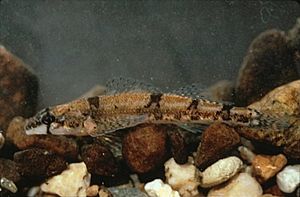Amber darter facts for kids
Quick facts for kids Amber darter |
|
|---|---|
 |
|
| Conservation status | |
| Scientific classification | |
| Genus: |
Percina
|
| Species: |
antesella
|
The amber darter (Percina antesella) is a small, special type of fish. It's a ray-finned fish, which means its fins are supported by bony rays. This fish belongs to the darter group, which is part of the Percidae family. This family also includes popular fish like perches.
Amber darters live in freshwater rivers in Georgia and Tennessee in the United States. They like areas where the water flows quickly over gravel and sand. They often hide in water plants. These darters eat tiny water creatures. The International Union for Conservation of Nature says the amber darter is an "endangered" species. This means it is at high risk of disappearing forever.
Contents
What Does It Look Like?
The amber darter is a small fish, usually less than 2.5 in (6.4 cm) long. It has a thin body. Its upper body is golden brown with dark, saddle-like markings. Its belly is a yellow or cream color. When male amber darters are ready to breed, their throats turn blue!
Where Do They Live and What Do They Eat?
The amber darter lives in the Conasauga River and Etowah River. These rivers are found in northern Georgia and southeastern Tennessee. They prefer parts of the river called "riffles." Riffles are shallow areas where the water flows quickly over rocks and gravel. They also like sandy bottoms.
During the summer, when water plants grow, amber darters use these plants for cover. They also find food there. Amber darters mainly eat small water creatures. These include snails and aquatic insects.
Why Are They Endangered?
The amber darter is an uncommon fish. It lives in only a few places. Because of this, many things can threaten its survival. For example, a new reservoir (a man-made lake) might change the water quality. It could also change the places where the amber darter lives.
Other activities can also harm the amber darter. These include logging (cutting down trees), chemical spills, or construction. All of these can make the water or habitat unhealthy. People are working to protect the amber darter. They are focusing on keeping its river homes safe and clean. The International Union for the Conservation of Nature has officially listed the amber darter as "endangered."
- Froese, Rainer, and Daniel Pauly, eds. (2006). "Percina antesella" in FishBase. January 2006 version.
See also
In Spanish: Percina antesella para niños



